Why Not Travel To. . . Spain?
For US citizens right now is a great opportunity to explore Spain. The euro is near par with the dollar, something that hasn't happened since the euro was brought into existence 12 years ago. To top that the Spanish economy right now is less than healthy, causing low hotel, food, and travel costs though out Spain. In February I went on a 9 day trip to Madrid and Granada. On my first day in Spain I took 300 euros out of the ATM which I intended to use for travel within Spain (on the ALSA bus system) and all food, drinks, and bar tabs. The day before I left I walked into a swanky wine shop dead set on spending the 100 remaining euros on souvenirs in the form of wine bottles. If you ever plan on visiting Spain, you might consider going sooner rather than later.
Madrid
I was fortunate enough to have a friend from Madrid to show me around while there. That being said, I learned enough vital information to pass on to those who might not be so lucky. Our first stop was a New Europe tour. This tour company you may never have heard of offers free walking tours in cities in Europe, the US, and the middle east. The gist is that at the end of the tour, you pay what you feel the tour was worth. Our tour of Madrid latest about 3 hours and covered most of the historic district. My friend who grew up in Madrid said she learned a lot on the tour. So thinking the tour comprehensive and entertaining, I tipped the guide well. Another activity we did in Madrid was go out to a club. If you go out to a club in Madrid, you might forget you are in a foreign country for a little bit, because all of the songs are in english. You will remember when the club closes down. . . at 6 AM and you walk outside to see the sun. Getting around Madrid is relatively easy due to the subway system, even at odd hours like 6 AM on a Sunday. The price to use the subway is the same no matter what your destination is. If you will be using the subway a lot. Buy a pass that is good for at least 10 rides, so you don't have the fiddle with the pay machine every time you want to catch a train.
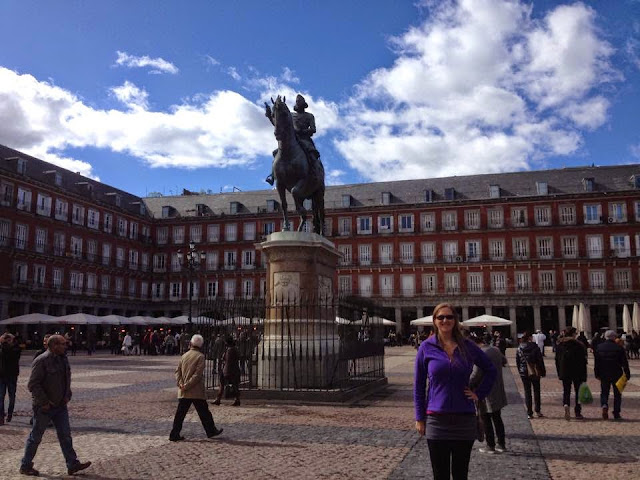 |
| Plaza Mayor, the meeting point of the New Europe Walking Tour. |
Granada
The bulk of my time was spent in Granada in the south of Spain. To get there from Madrid, a 4-5 hour drive, we booked tickets on the ALSA bus system for less than 15 euros each. You could take the high speed train, but that will cost you a lot more money. I cannot say enough about how awesome Granada is. I got a little hotel room with private bathroom for 25 euros a night in the cathedral district. The city is small enough that you can walk everywhere. It has some of the most impressive historical buildings in Spain. This brings me to the Alhambra. I tried in vain to search websites ahead of time to determine what exactly the Alhambra is, but I didn't understand until I saw it, its an ancient complex of buildings, gardens, and museums. The main part of the Alhambra that most tourists want to see was originally built by Moorish Sultans in the 1300s, and later added to by Spanish rulers. It consists of a series of palaces which look like they were somehow magically transported from the middle east. Stalagmite like ceilings with intricate colorful designs cover the interiors. While much of the art is faded from years of exposure, you can still get an idea of what was once there. Entry into these palaces is regulated so that the interior is not overcrowded, although you may have to wait in line for a bit before entering.
 |
| Inside a palace of the Alhambra |
If you want to see some Moorish art from the same period of the Alhambra that is in better condition, you should consider checking out the Palacio de la Madraza. The palacio is located next to the Granada cathedral, and it costs a couple of euros to enter. The palacio was originally a school for the study of Islam, and has much of the same architecture of the Alhambra on a small scale. When the catholic kings retook Granada from the Moors, the palacio was converted into the first town halls and all of the Moorish art was covered in wood paneling, which preserved the art for hundreds of years. The palacio is now owned and maintained by the University of Granada.
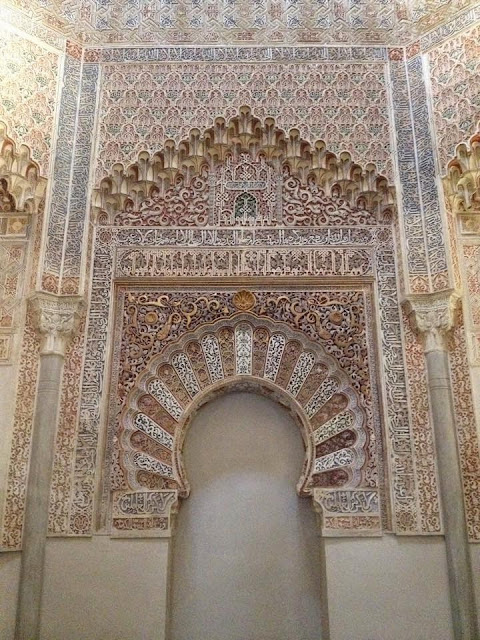 |
| The interior of the Palacio de la Madraza |
After visiting the palacio, you can walk directly across the street to see the burial place of the Catholic Monarchs of Spain. This is the very Queen Isabella and King Ferdinand the second who funded Christopher Columbus' expedition across the Atlantic Ocean. Like the palacio, it will cost 4 euros to enter. Walk around the corner of the tomb and you will find the entrance to the Granada Cathedral. As you may have guessed by now entry into the cathedral will cost another few euros. The Cathdral is worth the donation though. Chapels rim the main body of the cathedral that are profusely decorated in gold, while the main dome displays paintings and statues of the 12 apostles. Keep a look out for a sculpture of the patron saint of Spain trampling a Moor under his horse.
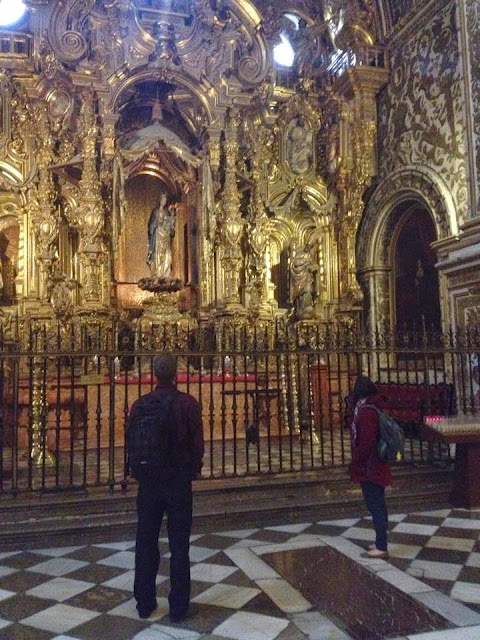 |
| The interior of the Cathedral of Granada. |
One restaurant I did visit in Granda was La Chumbera. La Chumbera means the cactus, and the restaurant is located int he heart of the Albaicin neighborhood. The restaurant consists of a series of patios that overlook the Alhambra and dinning rooms located in caves within the mountain. A flamenco show is also included with your dinner. At first I was less than enthused by the idea of a flamenco show, but I was pleasantly surprised. Flamenco is a lot like a cappella. Yes there is a guitarist, but the flamenco dances add in harmony with their voices, clapping, snapping their fingers, and stomping the heels of their shoes. I never thought it was physically possible for someone to snap their fingers so loudly.
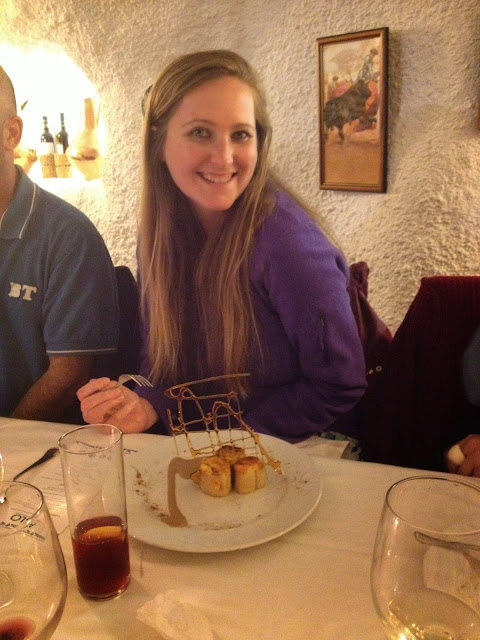 |
| My delectable dessert at La Chumbera in one of the cave dinning rooms. |
| The view of the Alhambra from La Chumbera |
So why not travel to Spain? Don't speak the language? Which one? Spain actually has 4 official languages. Spanish of course is spoken by most Spaniards, but there is also Basque, spoken on the northern boarder where the Basque cultural area is (half in Spain half in France), Catalan and Aranese which are spoken on the east coast most notably in the city of Barcelona, and Galician which is somewhat a mix of Spanish and Portuguese and spoken in the area of Spain north of Portugal. It is extremely rare to find a Spaniard who speaks all of the official languages of Spain. So in a way not even Spaniards speak the language depending on the region they are in.
Two more tips before I end:
When in Basque county they do not have tapas but pinchos, which means "to pinch" and are skewered by a toothpick. At a pinches restaurant waiters walk around with trays of pinchos. When something comes by that looks good, you just grab it off the tray. When you are ready to go, the waiters bill you by how many skewers or toothpicks are on your plate.
Don't leave more than a euro for a tip. Waiters are paid a better salary, and tip is not expected.
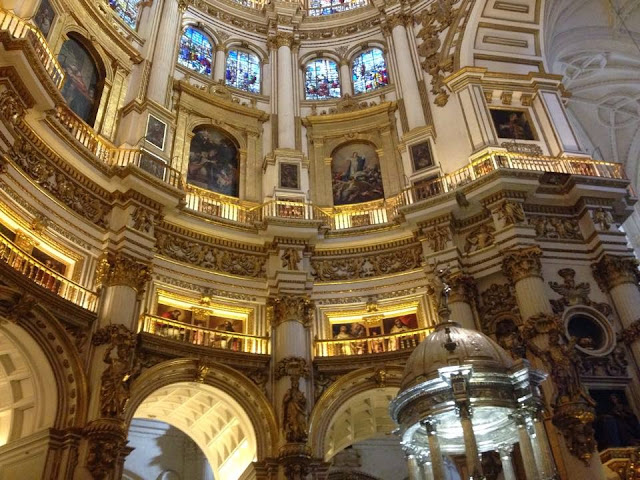
No comments:
Post a Comment